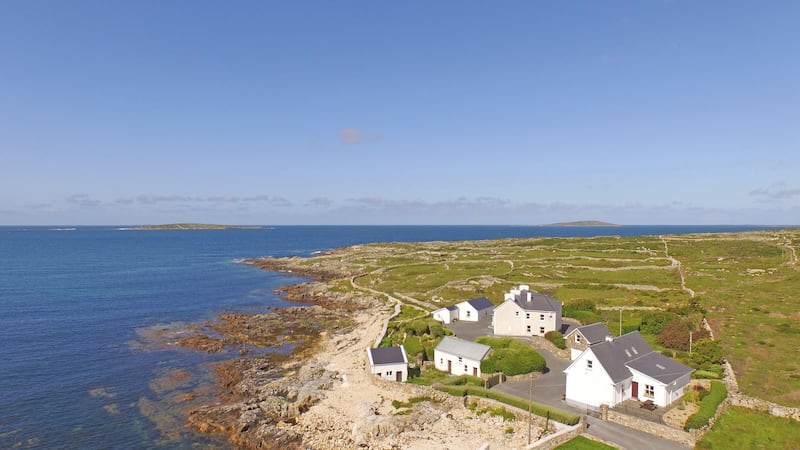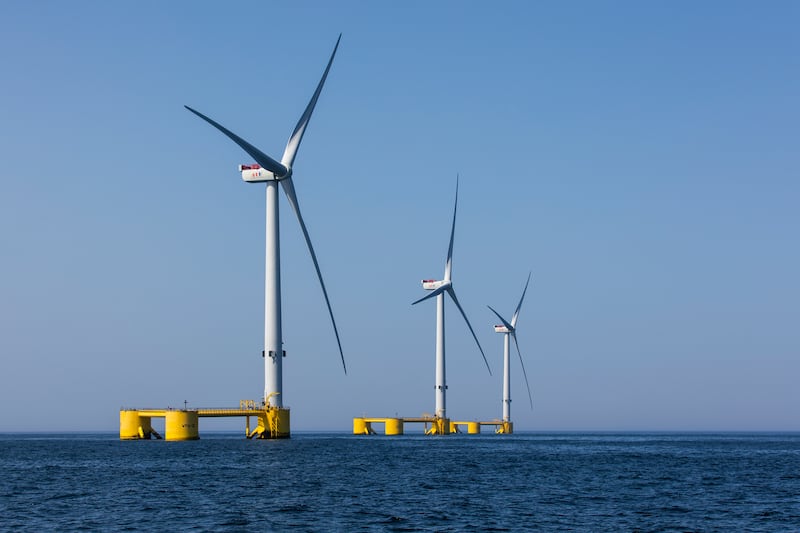Ireland is at the point of scale-up of its vast offshore wind resources. The green light is months rather than years away for the first tranche of wind farms. Some communities will soon see renewable energy progress in the form of what one campaign group calls “mountain-high turbines”.
The Government has issued marine area consents (MACs) for seven projects using fixed-foundation turbines; six in the Irish Sea and one off Co Galway. The projects are being fast-tracked in a streamlined planning process. All are likely to be granted foreshore licences to intensively survey locations in advance of submitting planning applications this year.
They will take part in Ireland’s first offshore renewable electricity support scheme auction shortly, bidding to supply energy in a 20-year time frame.
We can have everything: renewable energy, decarbonisation, the technology to allow turbines beyond 22km ... without industrialising the coastline
— Mick O’Meara of the Blue Horizon campaign group
This is the first phase to generate seven gigawatts of offshore power by 2030 – more than enough for the country’s electricity needs, putting Ireland on a path to becoming a renewables exporter.
Assuming planning hurdles are cleared, the turbines’ imposing presence will be obvious in an almost continuous line looking out to sea from Co Louth to Co Wexford, but perhaps most obviously on the coastline of southwest Connemara, at Sceirde Rocks.
At that location there are likely to be up to 30 turbines reaching more than 300 metres – as tall as the Eiffel Tower – with the nearest just 5km from shore, part of a 450-megawatt development capable of powering 350,000 homes and costing up to €2 billion.
If ever there was a panorama capturing the west of Ireland’s beauty it is the view out to sea from Carna in Connemara. When the sun is shining, St MacDara’s Island (Oileán Mhic Dara), Mason Island (Oileán Máisin) and Mweenish Island (Oileán Muighinis) appear as if dropped into turquoise waters in a line, with golden sands peppering the seascape and Sceirde Rocks immediately beyond.
The developer, Fuinneamh Sceirde Teoranta (FST), is owned by Macquarie’s Green Investment Group (GIG), which has set up Corio Generation to manage its wind portfolio with global infrastructure investor Ontario Teachers’ Pension Plan. Some 30 local fishermen were compensated for keeping out of the area last year during surveying.
According to Hugh Ryan of Ard Thiar, Carna, there should be a review to establish the impact “proposed mega turbines” will have on the local environment and landscape above and below the water line before permission is granted for a wind farm at Sceirde Rocks.

In a letter to Minister for Energy Eamon Ryan, he underlined this should be in the context of far larger turbines being used than originally envisaged in 2008 and the new option of floating turbines farther out to sea.
Sceirde Rocks is a unique feature off the west coast while MacDara’s Island, which is closest to the rocks, has one of Ireland’s finest examples of an early Christian oratory, noted Hugh Ryan. “There has been much success in developing the Wild Atlantic Way. Both the Sceirde Rocks and MacDara’s Island are an integral part of the beauty and wildness of this coast. Carna and its neighbouring villages are trying to bring tourism into the area. A project of [this] scale ... will desecrate such a wild and beautiful area.”
He said he was alarmed by the lack of proposed marine life protection. The shallow reef between Sceirde Rocks and MacDara’s Island provides an excellent habitat for lobster and crab. Local fishermen have fished these waters sustainably for generations. “The drilling and associated disturbance proposed in the application will have huge repercussions for this habitat,” he argued.
The drilling and associated disturbance proposed in application will have huge repercussions for this habitat, he believed.
Mace Head weather station is located nearby, a globally-important facility for monitoring air quality in the atmosphere. It is positioned far away from major urban areas to ensure no pollutants interfere with measurements. It recorded the cleanest air in Europe last year.
“If this windfarm goes ahead the station will have to be relocated due to the impact the turbines will have on air movement and the contamination of the air by pollutants produced during the construction phase as well as the use of anti-corrosion chemicals on a maintenance basis,” Ryan submitted.
Many countries insist offshore wind farms are located at least 15-20km from the shore – beyond the horizon, while floating structures can be anchored in operation and removed when decommissioned, he said.
Hugh Ryan acknowledged the rush to get wind farms up and running to reduce emissions. “Planning for a floating wind farm further offshore could be fast-tracked. This would allow us to avoid making a decision that could be regretted for generations to come.”
Among submissions on the foreshore licence application, civil engineer Siobhán Kennedy, who lives on Muighinis, near Carna, said there were deficiencies in FST’s environmental assessment, including a failure to demonstrate how the Government’s 2023 climate plan requirement for “development of offshore renewable energy to progress at pace alongside the conservation, protection and recovery of marine biodiversity” will be met.
She submitted that the GIG has a poor track record in terms of financial management, maintenance of infrastructure and protection of the environment – claims denied by GIG.
“Given the scale of the risk involved – drilling 60 boreholes into the seabed in an important marine area cannot be without impact – is this really the type of actor we wish to have involved? How can any of the documents associated with the foreshore licence application be taken at face value if the independent trustees [Green Purposes Company] tasked with ensuring GIG delivers truly impactful and effective green infrastructure projects are highlighting a lack of transparency across multiple key areas of GIG’s work?”
If FST is allowed to proceed, said Elin Payne of Ard Thiar, then the Government “can be credibly accused of greenwashing by promoting its ‘fast-tracking’ of wind-generated energy production for Ireland while disregarding the significant negative environmental consequences to the local seabed, the marine life that inhabits it, the coastal landscape and the fishing and tourism that sustain this pristine section of coastline”.
Donnacha Gallagher conducted a study of visual intrusion for a postgraduate degree at DCU. He concluded that if accepting that wind farms are going to become a feature in seascapes, there must be consensus on what the public finds visually appealing or acceptable, with this backed by rules or regulations.
An essential area for guidance concerns height-to-distance ratios and field-of-view angles. If FST has turbines over 300 metres, that ratio and angle will be particularly imposing for Carna residents; less so at Roundstone.
Gallagher believes treasured seascapes need to be catalogued to ensure they are not impacted. “The more controversial sites will be the long stretch of turbines along the Wicklow coast, and potentially the Waterford coast,” he says.
The least impactful developments with turbine clusters will get planning permission while the most impactful will face delays, he predicts.
[ Fintan O’Toole: The EU has a vast untapped energy resource – IrelandOpens in new window ]
Mick O’Meara of Blue Horizon is part of a campaign group with a single mantra: “Yes to offshore wind – No to nearshore wind” off the south coast. Under the next offshore tranche, at least 12 projects are planned for the Celtic Sea; four are fixed-bottom, less than 10km from shore.
“We can have everything: renewable energy, decarbonisation, the technology to allow turbines beyond 22km,” says O’Meara, while “preserving culture, heritage and a sense of peace looking out at the horizon and leaving the world behind, rather than industrialising the coastline”.
Citing projects in Scandinavia and Portugal, he believes floating technology is readily available.

O’Meara stresses that his group has no truck with nimbyism but is adamant that having “mountain-high turbines” nearshore is an unnecessary intrusion – as fixed-bottom turbines can go out to deeper waters of 60m-plus.
“I have kayaked around Ireland twice ... I have sat on MacDara Island. There will be turbines 3km away. What are they thinking?”
A Corio spokesman confirmed there could up to 30 fixed-bottom turbines; the precise number will be decided after geotechnical testing this summer. The turbine height will depend on the final design and available technology, said the spokesman. It will connect to EirGrid’s transmission system at Moneypoint.
“The project has a fisheries liaison officer as part of its team and engaged with over 40 separate fishers in the area, and successfully completed surveys last summer ... Photomontages of the proposed wind farm will be published this summer,” said the spokesman.
“The wind farm will contribute significantly to the future development of the local area, through job opportunities and economic development ... It will have a community benefit fund that will strengthen and support cultural economic and community infrastructure in the Gaeltacht area,” he added.
A GIG spokesman said: “We value our positive and constructive relationship with the Green Purposes Company and we were pleased that their most recent letter concluded that GIG remains a market leader in green investment with expertise to shift the dial on flow of capital into green projects. However, we don’t rest on that position and welcome the trustees’ feedback as we grow our business and accelerate investment in the energy transition.”
[ Wind farms to get paid for electricity they do not supplyOpens in new window ]
With two fishing boats, one operating from Roundstone and the other in the Irish Sea, fisherman Kevin Conneely says “you would do well to find someone worse affected” by the first-phase projects, five of which are in areas he fishes all year round.
He took a legal case to ensure he continues to have the right to fish at Sceirde Rocks – securing agreement cost him €25,000. There is no agreement on any compensation for him but if the five projects proceed “I will be out of business”, he maintains.
The FST turbines will be higher than Errisbeg, which dominates the landscape around Roundstone, says Conneely.
“It’s enough to keep you awake at night. There is poor consultation or they say things will be sorted and they aren’t. It’s out of the control of the State.
“If we are the cost of saving the planet, come out and say it,” he adds, predicting no fishers will be allowed tow gear in among offshore wind farms.
Carna boatbuilder John Casey points to the uniqueness of Sceirde Rocks – an area his father used to fish. He has a lingering concern that not enough surveying of its habitats and bedrock will be carried out: “I wouldn’t want that to be affected.”
Renewable energy is obviously the way forward, says Casey, but he fears this wind farm will be obsolete in 20 years. He favours using floating turbines farther out.
[ Public supports wind turbines in their areas, claims lobby groupOpens in new window ]
There is interest in FST’s development fund to support the local community in an area of declining population and to which people find it hard to return after leaving for college. Some locals are fearful, but Casey believes the correct decision will be made, if backed by proper research.




















